Spinal stenosis explanation
Spinal stenosis explanation will tell you how your back can cause tingling, pain and weakness in your arms and legs.
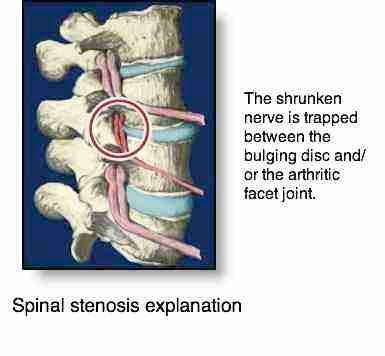
This page was last updated by Dr Barrie Lewis on 19th April, 2019..
A narrowing in any part of the spine, mostly the neck or lower back, may stress the spinal cord and cause symptoms and signs in the arms and legs, and even the organs of the body.
The spine gives both support to the body and protection to the spinal cord as it passes to and from the brain to the arms and legs and, of course, the organs. This next patient died of kidney failure, supposedly caused by the pinched nerve.
The spinal cord can be seen here, snugly within the spinal canal, surrounded by bone, ligaments and joints.
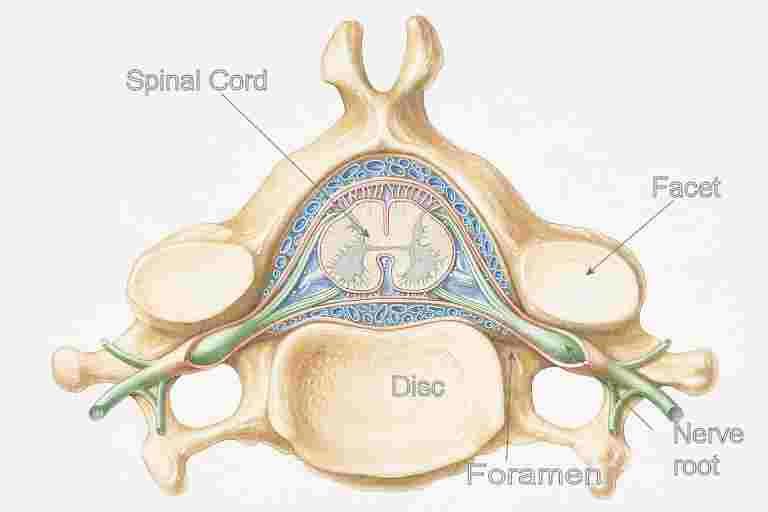
Any swelling of the yellow ligament that lies in the spinal canal, or degenerative changes in the facet or disc joints, or a slipped disk, may affect the cord and nerve roots.
In the lower neck, a small appendage called an uncinate process is often injured in a whiplash injury. If untreated they become arthritic invading the foramen and causing pain and tingling in the arm. They form the uncovertebral joints of Luschka.
In the neck the yellow ligament is thin and rarely contributes to spinal stenosis but in the lumbar area, after long years of chronic low back pain, it becomes thickened; then it may be a major factor in the numbness and tingling in the legs and feet.
Degenerative changes associated with a chronic lumbar or cervical facet syndrome, or slipped disc and occasionally a childhood fracture in the lower back called a spondylolysthesis are the major contributors to our spinal stenosis explanation.
- Cervical Facet Syndrome ...
- Lumbar slipped disk joint symptoms.
- Yellow ligament spinal stenosis in the lower back
- A childhood fracture called a SPONDYLOLYSTHESIS can cause spinal stenosis ....
In our spinal stenosis explanation of the changes in the cervical spine we describe how the symptoms are often worsened by neck flexion.
For example a reflex in the lower leg may diminish on flexing the neck, whereas extension of the cervical spine may affect the arms, cause nerve pain and tingling.
However in the lumbar spine, bending forwards usually relieves the symptoms in the back and legs; and again it is extension that increases the pain and tingling in the lower limbs.
The cause, both in the neck and the lower back is usually facet and disc joint related damage due to Immobilisation Arthritis.
Hyaline cartilage
Hyaline cartilage is the most important page at chiropractic help;
understanding it is at the heart of this spinal stenosis explanation.
See in this section below, the super-smooth healthy cartilage in a sheep's neck? Its coefficient of friction is lower than ice, literally. This enables you to turn your neck freely and without restriction.
Don't underestimate the influence of enjoying anti-inflammatory foods in your diet on a daily basis in the prevention of spinal stenosis explanation; many of them also contain flavonoids with proven prevention of malignancies.
However, after trauma, such as in whiplash, a fall from a horse or down a Dutch staircase, the normal flow of synovial fluid carrying oxygen and nutrients to the cartilage is restricted. The result... immobilisation arthritis. The cartilage loses its super-smooth characteristics, becomes pitted and starts forming bony spurs, the first part of the process known as spinal stenosis explanation.
Our mutton stew page has a super low-cholesterol lamb recipe.
One of things you can do for your hyaline cartilage is to make sure it gets plenty of omega-3; fatty fish comes first and foremost to mind. But true free range eggs, if you can find them, have three times as much of this very important fatty acid; kids perform better in school too; but unless the hens have best chicken feed don't expect them to produce these extra nutritional benefits.
Chiropractic
In the chiropractic profession we believe strongly in the combination of exercise, diet and mobilising fixated joints are at the heart of this spinal stenosis explanation.
Exercise so your don't need to consult your chiropractor twice every week to mobilise your joints; correct diet so the synovial fluids that supply nutrients to the hyaline cartilage are rich in the necessary anti inflammatory substances and adjustments of those subluxated spinal segments.
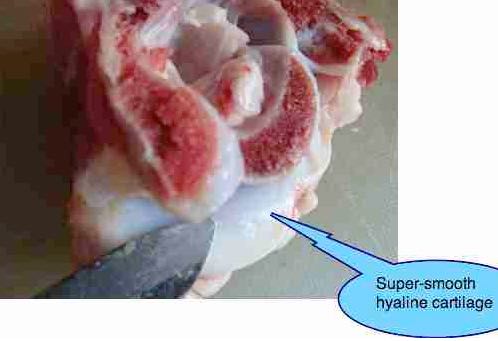
Spinal stenosis explanation
Spinal stenosis explanation outlines how chronic joint fixations cause narrowing of the spinal canal and foramena.
Symptoms of spinal stenosis
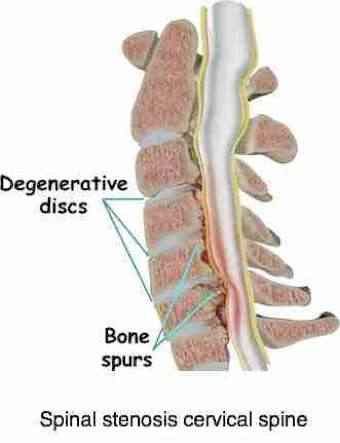
If the narrowing is in the neck then it may affect the legs (and the arms, obviously) as the nerves to the legs must pass through the neck. Thus a weak muscle in the lower leg, due to cervical spinal stenosis could be the underlying cause of a sprained ankle. I have recently had such a case. Referral for a neurological consult confirmed the spinal stenosis, and major spinal surgery actually greatly relieved the man's symptoms and signs.
Tingling in the arms and hands are often the spinal stenosis symptoms associated with degenerative changes in the neck. Read more about SYMPTOMS OF CERVICAL STENOSIS ...
Lumbar spinal stenosis (LSS)
The typical patient is older than 70 years old and has bilateral buttock and/ or leg pain. Typical symptoms are a heavy feeling in the legs, cramps with pain and or numbness. Noteworthy is that there is usually no pain when sitting.
Pain in the low back is relieved by bending forwards, and is worsened dramatically on extension (bending backwards). This is one of the most common signs. To alleviate the pain, the patient often walks in a stooped posture. Femoral Nerve CaseFile; pain in the groin and front of the thigh.
Do you recognise the artist? He's arguably the most famous artist who ever lived. I have just been to the "Complete Rembrandt" in Amsterdam, perhaps the most stunning exhibition I have ever seen. Over a 1000 pieces of Rembrandt. This man is probably suffering from lumbar stenosis.
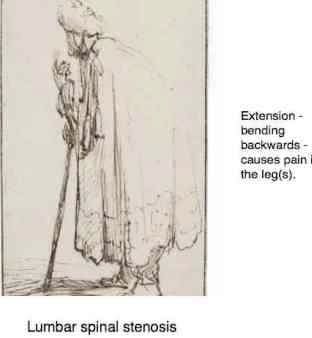
The pain in the buttocks and/ or legs often is worse with walking, and immediately relieved by sitting, so-called "neurogenic claudication".
It's not that clear in the Rembrandt, but the patient often walks with a broad-based stance, balance is poor and s/he has an abnormal Romberg test.
Spinal stenosis exercises
In order to keep the facet joints healthy they need daily gentle exercise. Every morning, do these simple exercises which allow the facet joints to glide over each other in a non-stressful way. The synovial fluid carrying nutrients and oxygen to the joint is refreshed and any rough bits of the hyaline cartilage are gently polished off.
- SPINAL STENOSIS EXERCISE ...
- Lower back and leg pain exercises
Walking speed
Interesting 2011 research, reported in JAMA reveals that training yourself to walk faster, and dealing with the problems (like hip arthritis ) that slow you down, will add decades to your life. Quality years, what's more.
Spondylolysthesis
This is yet another of the causes of sciatica. There are two types of Spondylo-lys-thesis.
One vertebra slides forwards on its nearest neighbour. The first kind is caused by a fracture, usually in childhood, and is often stable. The other caused by severe wear-and-tear of the facet joints is more troublesome often causing lower back and leg pain and contributing to this spinal stenosis explanation.
- SPONDYLOLYSTHESIS CaseFile ...
- LOWER BACK AND LEG PAIN ...
Tumours
Tumours can mimic the symptoms of spinal stenosis.
Very occasionally spinal stenosis may cause bladder and bowel dysfunction. Such symptoms may also be caused by a tumour lying within the spinal canal; fortunately it's very rare.
Leg length inequality
Leg length inequality and spinal stenosis explanation belong together. A short leg causes increased wear in the hyaline cartilage in the joints.
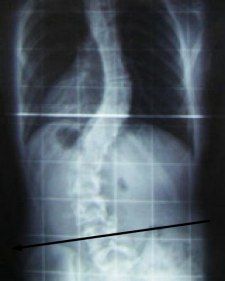
Or in normal jargon, could you have a short leg? Leg length inequality research confirms that a short leg causes not only hip and knee arthritis, but also lower lumbar back pain. It probably ultimately is also one of the causes of lumbar stenosis, and lateral disc herniation, though is unresearched. Leg length inequality and low back pain are now confirmed to be strongly associated.
Not responding to Chiropractic? Has your Chiropractor considered a short leg?
Here is a leg length inequality CaseFile that might interest you, and may just contribute to your spinal stenosis explanation.
Spinal surgery
Spinal surgery usually initially relieves the symptoms of low back and leg pain associated with a slipped disc, but fibrotic changes in and around the nerve may lead to a debilitating sciatica that defies all forms of treatment. Further operations simply further aggravate the complications of surgery resulting in yet more fibrosis and yet another cause of spinal stenosis explanation; Chiropractic treatment may or may not help.
Help for sciatic pain
When I did my training over thirty-five years ago lumbar stenosis was considered a surgical job, and frankly I probably refused to treat it for twenty years. Those were the days before scans and the diagnosis for spinal stenosis explanation was made on the basis of Eisenstein's radiological lines.
But gradually one gains confidence with time and experience in the treatment of more difficult cases. Slipped disc symptoms and signs are no longer a terror in the night to the experienced chiropractor and whilst I would never treat Lumbar stenosis as routine, most patients who are willing to work with me, follow the rules, come for treatment, and do their exercises faithfully respond well.
Only yesterday an elderly lady (83) consulted me for hip pain. Two years ago she first came with severe pain down the front of the leg - in the femoral nerve distribution. When I gave her the spinal stenosis explanation (a degenerative spondylolysthesis) she was flabbergasted and unbelieving: she had been told that only surgery could fix her. Yesterday, she had no back pain, and no pain radiating down the thigh... just a little hip arthritis pain.
If you go the Chiropractic route for treatment for sciatica, a femoral nerve entrapment too, recognise you will have to work at it yourself. Mind you, that's just as true of surgery... it's a rare week that goes by when one is not consulted by a patient who has two, and even three little scars down in the low back. This week a sad message from a patient of a friend who had just died shortly after her fourth back surgery...
We are adding exercises to
relieve sciatica and femoral nerve pain to this site. Making good
quality films and adding them to the site is technically challenging! We
are working at it...
LOWER BACK EXERCISES ...
Use the site search function to locate these pages.
Think twice before neck surgery
"I have been living with these symptoms for years. I had surgery
on my neck for it 12 years ago, and although it probably kept me from
getting worse, I've had to live with neck pain that has been almost
crippling - in fact it caused me to leave my 30 year career.
If I
had to do it over again, I think I would have put off or avoided having
surgery for cervical spinal stenosis because now, not only do I have to
live with the annoying and distracting sensations in my legs, I have to
live with the neck pain from the surgery."
Magnesium deficiency
Magnesium deficiency and spinal stenosis explanation are certainly connected, and that's why healthy choice foods are so important for everyone. If you're still on the black and white diet, meat and potatoes, you can expect arthritis of the joints. Step up to colour, as in TV.
Spinal stenosis is amongst other things a form of chronic arthritis.
A magnesium deficiency has been identified at being at the root of many cases of arthritis.
Spinach is the richest source of magnesium, but take care because 30% is leached out in the cooking. Steam, or use the water to make soups and gravies. Popeye wasn't so dumb after all.
Bernie's healthy spinach dip is one easy way to increase your magnesium and give protection against this form of arthritis.
- HOW TO GROW SPINACH ...
- Interesting facts about strawberries is about prevention of arthritis.
- Arm pain radiating from the neck.
- Leg pain sciatica emanating from the low back.
- Fish oil benefits for the prevention of spinal degenerative changes.
- Managing lower back pain is a book by eminent surgeon Dr Kirkaldy-Wallis.
- Chiropractic treatment of lumbar stenosis; a literature review
- Kaempferol and cancer prevention. Web: https://tinyurl.com/yuep3mam
When browsing these links use right click and "Open Link in New Tab", or you may get a bad gateway signal.
Did you find this page useful? Then perhaps forward it to a suffering friend. Better still, Tweet or Face Book it.
